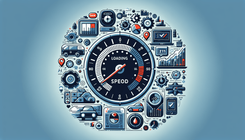How to Improve Your Shopify Store's Loading Time by Reducing Unused Scripts and CSS, Optimizing Video and Images
Introduction
In the fast-paced world of eCommerce, website speed is crucial. A slow-loading site can lead to poor user experience, higher bounce rates, and lost sales. For Shopify store owners, optimizing website speed involves multiple facets, including reducing unused scripts and CSS, and optimizing videos and images. In this guide, we will explore the reasons behind slow website loading times and provide a comprehensive step-by-step approach to solve these issues.
Why Website Speed Matters
Website speed is more than just a vanity metric; it directly impacts your bottom line. Here are a few reasons why speed is crucial for your Shopify store:
- User Experience: Fast websites offer a better user experience, leading to increased engagement and higher conversion rates.
- SEO: Google considers page speed a ranking factor. Faster sites rank better in search engine results.
- Reduced Bounce Rates: Users are more likely to leave a slow-loading site, increasing your bounce rate and impacting your SEO and conversion metrics.
- Higher Conversion Rates: A faster site can lead to improved conversion rates, driving more sales and revenue.
Common Causes of Slow Website Loading Times
Before diving into the solutions, it's essential to understand the common culprits behind slow-loading Shopify stores:
- Unoptimized Images and Videos: Large image and video files can severely impact your website load time.
- Unused CSS and JavaScript: Unused or unnecessary CSS and JavaScript files can bloat your website, making it load slower.
- Excessive App Installations: Installing too many apps can introduce additional scripts and styles, affecting performance.
- Poorly Designed Themes: Some themes are not optimized for speed and come with a lot of bloat.
- Large DOM Sizes: A large DOM size can slow down the rendering of your webpage.
Step-by-Step Guide to Improve Shopify Website Speed
1. Auditing Your Theme
Begin by auditing your theme files to identify unused scripts and CSS. Here's how you can do it:
Review Theme Files:
- Access your Shopify admin panel.
- Navigate to Online Store > Themes > Actions > Edit Code.
- Review JavaScript, CSS files, and Liquid templates for any unused code.
Tools for Audit:
- Use tools like Chrome DevTools to inspect your pages and identify any unused JavaScript and CSS.
2. Minification and Concatenation
Minifying and concatenating your CSS and JavaScript files can reduce file sizes and improve load times.
Minify CSS and JavaScript Files:
- Use online tools or npm packages (e.g., UglifyJS for JavaScript, CSSnano for CSS) to minify your files.
Concatenate Files:
- Combine multiple CSS and JavaScript files into one to reduce HTTP requests. This can be done manually or via build tools like Webpack or Gulp.
3. Optimize Images and Videos
Images and videos are often the largest assets on a webpage and can significantly affect load times.
Optimize Images:
- Use image editing tools to compress images without losing quality.
- Save images in appropriate formats (JPEG for photos, PNG for graphics).
- Use lazy loading to defer offscreen images from loading until they're needed.
Optimize Videos:
- Compress videos before uploading using tools like HandBrake.
- Use modern video formats like MP4 or WebM.
- Implement lazy loading for videos.
4. App Management
Review and optimize the apps you have installed in your Shopify store, as some may inject additional scripts or CSS.
Evaluate Installed Apps:
- List all installed apps and evaluate their necessity.
- Disable or remove any apps that are not critical to your store’s functionality.
Check for Impact:
- Use tools like Google PageSpeed Insights to check the impact of apps on loading times.
- Look for alternative apps that are optimized for speed if necessary.
5. Regular Maintenance
Make regular maintenance a habit to ensure ongoing optimal performance for your Shopify store.
Regular Cleanup:
- Schedule regular audits to check for unused code and redundant assets.
- Regularly update your theme and plugins to benefit from performance improvements.
Monitoring Tools:
- Use tools like Google Analytics and Lighthouse to monitor your website’s speed performance over time.
Common Questions and Answers
Q1: How do unused scripts and CSS affect my website speed?
Unused scripts and CSS files increase the size of your webpage, causing longer load times. Every additional byte and HTTP request adds to the total time it takes for your page to load.
Q2: What is lazy loading, and how does it help?
Lazy loading defers the loading of non-essential resources (like images and videos) until they are needed. This can significantly improve initial load times and overall user experience.
Q3: Can too many apps slow down my Shopify store?
Yes, each app may add its own JavaScript, CSS, and other assets, which can accumulate and slow down your website. Regularly evaluate and remove unnecessary apps to keep your store lean and fast.
Q4: What are the best tools for optimizing images and videos?
Some of the best tools for image optimization include TinyPNG, Compressor.io, and ImageOptim. For video compression, HandBrake is highly recommended.
Conclusion
Improving your Shopify store's loading time is vital for providing a better user experience, boosting SEO, and increasing conversion rates. By following the steps outlined in this guide—auditing your theme, minifying and concatenating files, optimizing images and videos, managing apps effectively, and conducting regular maintenance—you can significantly enhance your website's performance. Remember, speed is not just about numbers; it's about creating a seamless and enjoyable shopping experience for your customers.
By implementing these strategies, you’ll be well on your way to a faster, more efficient Shopify store that delights users and drives sales.
If you have any further questions or need professional assistance, feel free to reach out to Shopify experts who specialize in speed optimization. Happy optimizing!




